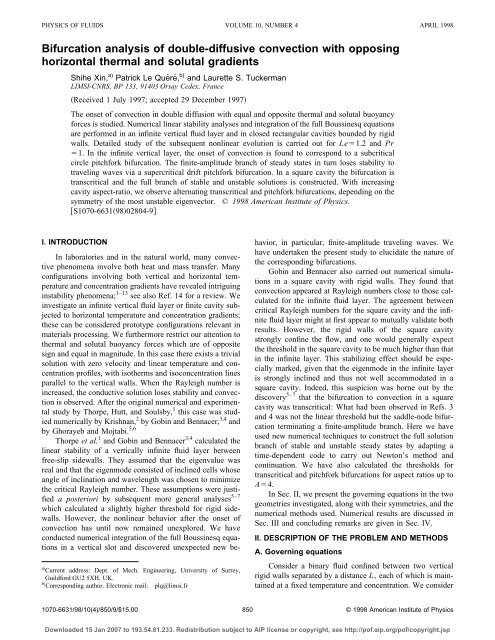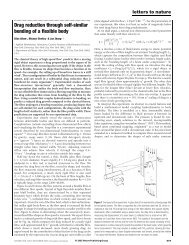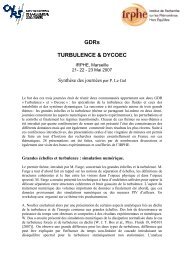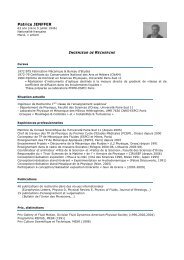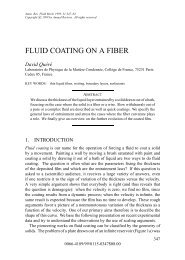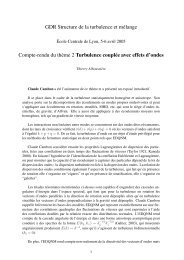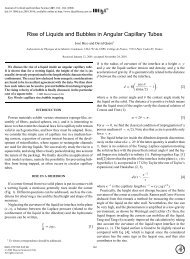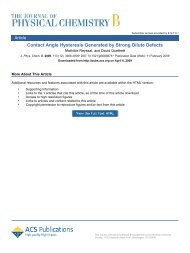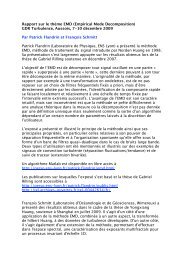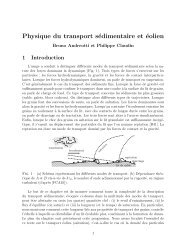Bifurcation analysis of double-diffusive convection with ... - Limsi
Bifurcation analysis of double-diffusive convection with ... - Limsi
Bifurcation analysis of double-diffusive convection with ... - Limsi
You also want an ePaper? Increase the reach of your titles
YUMPU automatically turns print PDFs into web optimized ePapers that Google loves.
PHYSICS OF FLUIDS VOLUME 10, NUMBER 4 APRIL 1998<strong>Bifurcation</strong> <strong>analysis</strong> <strong>of</strong> <strong>double</strong>-<strong>diffusive</strong> <strong>convection</strong> <strong>with</strong> opposinghorizontal thermal and solutal gradientsShihe Xin, a) Patrick Le Quéré, b) and Laurette S. TuckermanLIMSI-CNRS, BP 133, 91403 Orsay Cedex, FranceReceived 1 July 1997; accepted 29 December 1997The onset <strong>of</strong> <strong>convection</strong> in <strong>double</strong> diffusion <strong>with</strong> equal and opposite thermal and solutal buoyancyforces is studied. Numerical linear stability analyses and integration <strong>of</strong> the full Boussinesq equationsare performed in an infinite vertical fluid layer and in closed rectangular cavities bounded by rigidwalls. Detailed study <strong>of</strong> the subsequent nonlinear evolution is carried out for Le1.2 and Pr1. In the infinite vertical layer, the onset <strong>of</strong> <strong>convection</strong> is found to correspond to a subcriticalcircle pitchfork bifurcation. The finite-amplitude branch <strong>of</strong> steady states in turn loses stability totraveling waves via a supercritical drift pitchfork bifurcation. In a square cavity the bifurcation istranscritical and the full branch <strong>of</strong> stable and unstable solutions is constructed. With increasingcavity aspect-ratio, we observe alternating transcritical and pitchfork bifurcations, depending on thesymmetry <strong>of</strong> the most unstable eigenvector. © 1998 American Institute <strong>of</strong> Physics.S1070-66319802804-9I. INTRODUCTIONa Current address: Dept. <strong>of</strong> Mech. Engineering, University <strong>of</strong> Surrey,Guildford GU2 5XH, UK.b Corresponding author. Electronic mail: plq@limsi.frIn laboratories and in the natural world, many convectivephenomena involve both heat and mass transfer. Manyconfigurations involving both vertical and horizontal temperatureand concentration gradients have revealed intriguinginstability phenomena; 1–13 see also Ref. 14 for a review. Weinvestigate an infinite vertical fluid layer or finite cavity subjectedto horizontal temperature and concentration gradients;these can be considered prototype configurations relevant inmaterials processing. We furthermore restrict our attention tothermal and solutal buoyancy forces which are <strong>of</strong> oppositesign and equal in magnitude. In this case there exists a trivialsolution <strong>with</strong> zero velocity and linear temperature and concentrationpr<strong>of</strong>iles, <strong>with</strong> isotherms and isoconcentration linesparallel to the vertical walls. When the Rayleigh number isincreased, the conductive solution loses stability and <strong>convection</strong>is observed. After the original numerical and experimentalstudy by Thorpe, Hutt, and Soulsby, 1 this case was studiednumerically by Krishnan, 2 by Gobin and Bennacer, 3,4 andby Ghorayeb and Mojtabi. 5,6Thorpe et al. 1 and Gobin and Bennacer 3,4 calculated thelinear stability <strong>of</strong> a vertically infinite fluid layer betweenfree-slip sidewalls. They assumed that the eigenvalue wasreal and that the eigenmode consisted <strong>of</strong> inclined cells whoseangle <strong>of</strong> inclination and wavelength was chosen to minimizethe critical Rayleigh number. These assumptions were justifieda posteriori by subsequent more general analyses 5–7which calculated a slightly higher threshold for rigid sidewalls.However, the nonlinear behavior after the onset <strong>of</strong><strong>convection</strong> has until now remained unexplored. We haveconducted numerical integration <strong>of</strong> the full Boussinesq equationsin a vertical slot and discovered unexpected new behavior,in particular, finite-amplitude traveling waves. Wehave undertaken the present study to elucidate the nature <strong>of</strong>the corresponding bifurcations.Gobin and Bennacer also carried out numerical simulationsin a square cavity <strong>with</strong> rigid walls. They found that<strong>convection</strong> appeared at Rayleigh numbers close to those calculatedfor the infinite fluid layer. The agreement betweencritical Rayleigh numbers for the square cavity and the infinitefluid layer might at first appear to mutually validate bothresults. However, the rigid walls <strong>of</strong> the square cavitystrongly confine the flow, and one would generally expectthe threshold in the square cavity to be much higher than thatin the infinite layer. This stabilizing effect should be especiallymarked, given that the eigenmode in the infinite layeris strongly inclined and thus not well accommodated in asquare cavity. Indeed, this suspicion was borne out by thediscovery 5–7 that the bifurcation to <strong>convection</strong> in a squarecavity was transcritical: What had been observed in Refs. 3and 4 was not the linear threshold but the saddle-node bifurcationterminating a finite-amplitude branch. Here we haveused new numerical techniques to construct the full solutionbranch <strong>of</strong> stable and unstable steady states by adapting atime-dependent code to carry out Newton’s method andcontinuation. We have also calculated the thresholds fortranscritical and pitchfork bifurcations for aspect ratios up toA4.In Sec. II, we present the governing equations in the twogeometries investigated, along <strong>with</strong> their symmetries, and thenumerical methods used. Numerical results are discussed inSec. III and concluding remarks are given in Sec. IV.II. DESCRIPTION OF THE PROBLEM AND METHODSA. Governing equationsConsider a binary fluid confined between two verticalrigid walls separated by a distance L, each <strong>of</strong> which is maintainedat a fixed temperature and concentration. We consider1070-6631/98/10(4)/850/9/$15.00 850© 1998 American Institute <strong>of</strong> PhysicsDownloaded 15 Jan 2007 to 193.54.81.233. Redistribution subject to AIP license or copyright, see http://p<strong>of</strong>.aip.org/p<strong>of</strong>/copyright.jsp
Phys. Fluids, Vol. 10, No. 4, April 1998Xin, Le Quéré, and Tuckerman851C C CU Wt x z 1LeRa 2 C,1ewhere U,W are dimensionless velocity components, Ra C( g C CL 3 )/(D) is the solutal Rayleigh number, Pr isthe Prandtl number / and Le is the Lewis number /D.The flow domain is (x,z)0,10, A for the finitecavity where AH/L is the cavity aspect ratio. The verticallyinfinite fluid layer is assumed periodic, i.e, (x,z)0,10, where is the imposed wavelength. The verticalwalls are rigid and conducting, while the horizontalwalls <strong>of</strong> the finite cavity are rigid and adiabatic. The boundaryconditions areUW0.5C 0.50 at x0, 2aUW0.5C 0.50 at x1, 2bU,W,,C -periodic in z infinite cavity, 2cUW z Cz 0both an infinite vertical slot and a rectangular cavity <strong>with</strong>rigid adiabatic horizontal walls, as depicted in Fig. 1. Thetemperature and concentration differences imposed betweenthe vertical walls are TT 0 T 1 and CC 0 C 1 . Thebinary fluid’s properties are given by its kinematic viscosity, its thermal and solutal diffusivities and D, and its thermaland solutal expansion coefficients T and C . We assumethat the Dufour and Soret effects can be neglected andthat the Boussinesq approximation holds: In the buoyancyterm, the fluid density is thus expanded as (T,C) 0 (T r ,C r )1 T (TT r ) C (CC r ) where T r (T 0T 1 )/2 and C r (C 0 C 1 )/2.The equations are nondimensionalized by defining thereduced temperature (TT r )/(T 0 T 1 ) and the reducedconcentration C (CC r )/(C 0 C 1 ) and by scaling lengthby the distance L between the vertical walls and time byL 2 /(Ra), where Ra is the thermal Rayleigh number Ra( g T TL 3 )/(). The dimensionless Boussinesq equationsthen readUx Wz 0,UtWttUUxUWxFIG. 1. Cavity configurations.U PW z x PrRa 2 U,W PW z z PrRa 2 W U Wx z 1Ra 2 ,Pr 1 Ra CLe Ra C ,1a1b1c1dat z0, A rectangular cavity.2dWe will consider only the case in which the buoyancyforces due to the thermal and solutal gradients are equal andopposite, i.e., we set the buoyancy number to 1N Ra CLeRa TT C C 1.3In the remainder <strong>of</strong> the article, we will thus fix Ra C LeRa and dispense <strong>with</strong> the parameter Ra C . In this case,Eqs. 1 <strong>with</strong> boundary conditions 2 possess the trivial conductivesolution ŪW¯0 and ¯(x,z)C¯(x,z)0.5x. Inorder to study the stability <strong>of</strong> the conductive solution, let uswrite Eqs. 1 in perturbation form. Using uUŪ, wWW¯, ¯, and cC C¯, Eq. 1 becomeux wz 0,utwtuuxuwxu Pw z x PrRa 2 u,4a4bw Pw z z PrRa 2 wPrc,4c uu wt x z 1Ra 2 ,4dc c cuu wt x z 1LeRa 2 c.4eThe corresponding boundary conditions are homogeneousuwc0 at x0,1, 5au,w,,c -periodic in z infinite cavity, 5buw z cz 0at z0, A rectangular cavity.5cThe linearized evolution equations are obtained by settingthe nonlinear terms in Eqs. 4 to zero. When Le1, theconductive solution is stable for all Rayleigh numbers, forthe following reason: Because the diffusion times <strong>of</strong> and care equal, the linearized versions <strong>of</strong> Eqs. 4d–4e implythat (c) obeys a diffusion equation. With homogeneousboundary conditions, (c) always decays to zero, and sothe buoyancy force Pr(c) <strong>of</strong> Eq. 4c cannot be maintained.When Le1, the diffusion times for temperature andDownloaded 15 Jan 2007 to 193.54.81.233. Redistribution subject to AIP license or copyright, see http://p<strong>of</strong>.aip.org/p<strong>of</strong>/copyright.jsp
852 Phys. Fluids, Vol. 10, No. 4, April 1998 Xin, Le Quéré, and Tuckermanconcentration are no longer equal and this argument nolonger holds. We denote by Ra c the critical thermal Rayleighnumber above which the conductive solution is unstable. Itcan easily be shown from Eqs. 4 that, for a steady bifurcation,Ra c (Le1) is a constant that depends only on theboundary conditions and is independent <strong>of</strong> Prandtl number.One consequence is that Ra c is infinite for Le1, as arguedabove.B. Numerical methodsExcept for the linear stability <strong>analysis</strong> <strong>of</strong> the vertical slot,all <strong>of</strong> our calculations are based on two pseudospectral timesteppingcodes, 15 which we have adapted to directly calculateeigenvectors and bifurcation points. The basis functionsin x are Chebyshev polynomials. In z, we use Fourier seriesfor the vertical slot and Chebyshev polynomials for the rectangularcavity. For the vertical slot, we use N x 30 modes inx, <strong>with</strong> a single Fourier mode for the linear stability <strong>analysis</strong>,and <strong>with</strong> N z 32 modes for nonlinear calculations. For rectangularcavities, we use N x 40 Chebyshev polynomials orgridpoints, and N z ranging from N z 40 for the square cavityA1 to N z 120 for A4. Our time-stepping scheme issecond order and combines numerical differentiation e.g.,Ref. 16 for the linear terms <strong>with</strong> Adams–Bashforth for thenonlinear terms. Incompressibility is enforced by a directUzawa method. 17 More details concerning the method can befound in Ref. 18.For the linear stability <strong>analysis</strong> <strong>of</strong> the vertical slot, theeigenmodes are <strong>of</strong> the form (,,c)(x,z,t)(ˆ ,ˆ,ĉ)(x)expizt, where is the streamfunction. The eigenvalueproblem for (ˆ ,ˆ ,ĉ)(x) resulting from linearizing Eqs.4 <strong>with</strong> boundary conditions 5a is discretized by Chebyshevcollocation 15 and is solved <strong>with</strong> subroutines from theNAG s<strong>of</strong>tware library; see Ref. 19 for more details. For each, the value <strong>of</strong> Ra at which Re()0 is found and theneutral curve is then constructed.In a rectangular cavity <strong>with</strong> rigid walls, the eigenmodesare no longer trigonometric in z, and so their dependence onz as well as on x must be determined numerically. Our discreteoperators are <strong>of</strong> size 4N x N z , i.e., between 6400and 19 200 for our study. We therefore use a version <strong>of</strong> theiterative power method to find only the eigenvalues <strong>of</strong> interest:By integrating the linearized version <strong>of</strong> Eqs. 4 <strong>with</strong>boundary conditions 5a and 5c in time, we are effectivelyacting repeatedly <strong>with</strong> the exponential <strong>of</strong> the Jacobianexp(J), whose dominant eigenvalues those <strong>of</strong> largest magnitudeare the leading eigenvalues those <strong>of</strong> largest real part<strong>of</strong> J. In order to find several leading eigenvalues, Arnoldi’smethod can be used. The details are described in Refs. 20–22. In order to calculate unstable solutions, we adapted thetime-stepping code to carry out Newton’s method for steadystate solving, as described in Refs. 22–24. Far from turningpoints, an initial guess for each solution (u,w,,c) along thebranch is obtained by quadratic extrapolation in Ra. Thisfails near a turning point, and one must consider instead thatRa and all but one selected field component w˜, here typicallyw x0.75, z0.25, are quadratic functions <strong>of</strong> w˜. Wefound that considering Ra as a dependent variable in thepredictor phase—i.e., in choosing an initial guess—sufficedto allow us to go around turning points <strong>with</strong>out having toconsider Ra as a dependent variable in the corrector phase—i.e., in the Newton iteration.We used Newton’s method to calculate steady bifurcationpoints. The linearized version <strong>of</strong> Eqs. 4 <strong>with</strong> / t 0and boundary conditions 5a and 5b or 5a and 5c canbe considered to be a nonlinear set <strong>of</strong> equations for the criticaleigenvector and Rayleigh number. The eigenvector isnormalized by fixing one <strong>of</strong> its components, and the Rayleighnumber becomes one <strong>of</strong> the unknowns. Newton’smethod determines directly and precisely the critical Rayleighnumber and corresponding eigenvector. The algorithmfor adapting the time-stepping code to carry out this procedureis given in Ref. 24.C. Symmetries1. Rectangular cavities: Z 2In a rectangular cavity, <strong>of</strong> aspect ratio A, Eqs. 4 <strong>with</strong>boundary conditions 5a and 5c are invariant under combinedreflection by x and z or, equivalently, under rotationby and by the inversion <strong>of</strong> the temperature and concentrationperturbation fields. Formally this can be described bythe action <strong>of</strong> the operator S defined byS 6cx,zc1x,Az,where is the streamfunction. If (,,c) is a solution toEqs. 4, 5a, and 5c, then so is S(,,c), i.e., Eqs. 4,5a, and 5c possess centro-symmetry.For the corresponding linearized problem, eigenmodeswill be either centro-symmetric, i.e., S(,,c)(,,c), oranti-centro-symmetric, i.e., S(,,c)(,,c). Centrosymmetriceigenmodes contain an odd number <strong>of</strong> cells whileanti-centro-symmetric eigenmodes contain an even number<strong>of</strong> cells. If a critical eigenmode is centro-symmetric, then thecorresponding bifurcation occurring in Eqs. 4, 5a, and5c is transcritical, while if a critical eigenmode is anticentro-symmetric,then the corresponding bifurcation is apitchfork. I,S is the group Z 2 , and the facts we have listedabove constitute the theory <strong>of</strong> bifurcation under Z 2 symmetry.See, e.g., Crawford and Knobloch 25 for more details.2. Vertical layer: O„2…In a vertically periodic slot <strong>with</strong> period , problem 4,5a, and 5b retains centro-symmetry, <strong>with</strong> the replacement<strong>of</strong> (Az) in Eq. 6 by (z). The problem also possessesthe additional symmetry <strong>of</strong> z-translation by any ẑ, describedby the operatorR ẑ mod .7cx,zcx,zẑTransformations 6 and 7 constitute a representation <strong>of</strong> thegroup O(2); see, e.g., Ref. 25.Downloaded 15 Jan 2007 to 193.54.81.233. Redistribution subject to AIP license or copyright, see http://p<strong>of</strong>.aip.org/p<strong>of</strong>/copyright.jsp
Phys. Fluids, Vol. 10, No. 4, April 1998Xin, Le Quéré, and Tuckerman853The eigenmodes which are solutions to the linearizedproblem are expected to break the translational symmetry.Hence, each eigenmode belongs to a ‘‘circle’’ <strong>of</strong> eigenmodes,related to one another by z-translation and sharing acommon eigenvalue. For each eigenmode, there exists a z 0about which it is centro-symmetric, i.e.,,cx,z,,c1x,zz 0 mod ,whereas it is anti-centro-symmetric about (z 0 /4) mod .The bifurcations <strong>of</strong> Eqs. 4, 5a, and 5b from conductionto <strong>convection</strong> lead to circles <strong>of</strong> equivalent steady states relatedto each other by z-translation, and are called circlepitchforks. These nonlinear steady states are, like the eigenmodes,centro-symmetric about some z 0 , but they are notanti-centro-symmetric about (z 0 /4) mod .The steady states are susceptible to a further bifurcation,called a drift pitchfork, 26–30 which breaks the centrosymmetryand leads to traveling waves whose wavespeed atonset vanishes. The eigenvalue associated <strong>with</strong> a drift pitchforkis zero at the bifurcation. This should be compared <strong>with</strong>a Hopf bifurcation, which is associated <strong>with</strong> a pair <strong>of</strong> complexconjugate eigenvalues and leads to traveling waveswhose wave speed is finite at onset.This sequence <strong>of</strong> bifurcations, or scenario, is <strong>of</strong>ten describedby the following set <strong>of</strong> ordinary differential equations,or normal form:ȧa 2 a,żs,8a8bṡa 2 1s 2 s.8cThe reflection and rotation symmetry operators S and R ẑ forthe normal form areSa,z,sa,z,s,9aR ẑ a,z,sa,zẑ mod ,s.9bEquations 8 have O(2) symmetry, an essential requirementfor the circle and drift pitchfork scenario, meaning that if(a,z,s) is a solution, then so are S(a,z,s) and R ẑ (a,z,s).In Eqs. 8, is a bifurcation parameter, analogous toRaRa c . The variable a represents the amplitude <strong>of</strong> <strong>convection</strong>.The -periodic variable z can be thought <strong>of</strong> as thelocation <strong>of</strong> some distinguished feature <strong>of</strong> the flow, e.g., avelocity maximum, vortex center, or stagnation point. Thevariable s represents a possible translational velocity. Theconductive state corresponds to as0. Equation 8a undergoesa pitchfork bifurcation at 0, leading to steadystates a <strong>of</strong> arbitrary phase zz 0 , and zero velocity s0. This is a circle pitchfork bifurcation for the system 8.Equation 8c then undergoes a pitchfork bifurcation at 1, leading to time-dependent solutions a <strong>with</strong> ‘‘drifting’’phase zz 0 st, whose velocity s1 is proportionalto the square root <strong>of</strong> the distance from threshold.Two circles <strong>of</strong> traveling wave solutions are created: Bothupwards-moving (s1) and downwards-moving (s1) solutions exist and are dynamically equivalent,and the solutions are also characterized by their initial phasez 0 . This is a drift pitchfork bifurcation for system 8a–8c.FIG. 2. Neutral curve for Le1.2 in a vertical fluid layer. Ra c 32 54510 and c 2.520.01.One or both <strong>of</strong> the pitchfork bifurcations may be made subcritical,by changing the sign <strong>of</strong> the a 2 term in Eq. 8a or <strong>of</strong>the s 2 term in Eq. 8c and adding higher order terms.We will see examples <strong>of</strong> circle and drift pitchfork bifurcationsin the next section.III. RESULTSA. Vertical layerWe have investigated several Prandtl numbers andLewis numbers. We find Ra c (Le1)65092, in agreement<strong>with</strong> Ghorayeb and Mojtabi. 5,6 The lower values 6137and 6122 reported by Thorpe et al. 1 and by Gobin andBennacer, 3,4 respectively, are easily attributed to the boundaryconditions: The sidewalls <strong>of</strong> our configuration are rigid,while those in Refs. 1, 3, and 4 are free-slip. For Le1.2 theneutral curve is displayed in Fig. 2. The minimum is atRa c 32 545, c 2.52, in agreement <strong>with</strong> Ghorayeb andMojtabi’s value <strong>of</strong> 2.53. The critical wave number c isindependent <strong>of</strong> both Prandtl and Lewis numbers. The criticalwavelength is c 2/ c 2.50.The corresponding critical eigenfunction, shown in Fig.3, consists <strong>of</strong> inclined cells similar to those depicted origi-FIG. 3. Critical eigenvector in a vertical fluid layer at Le1.2, Ra c32 545, and c 2.52. Left: Stream function. Middle: Temperature. Right:Concentration. Solid dashed contours denote positive negative values orcirculation.Downloaded 15 Jan 2007 to 193.54.81.233. Redistribution subject to AIP license or copyright, see http://p<strong>of</strong>.aip.org/p<strong>of</strong>/copyright.jsp
854 Phys. Fluids, Vol. 10, No. 4, April 1998 Xin, Le Quéré, and TuckermanFIG. 4. Evolution in time <strong>of</strong> u(x0.0423,z0.8594) at Ra3.410 4 ina vertical fluid layer. The initial conductive state (0t8500) is succeededby a plateau at an unstable finite amplitude state (9500t11500), andfinally by stable oscillations (t13 000).nally by Thorpe et al. 1 We can understand the qualitativeform <strong>of</strong> the eigenfunction physically by the following argument.Consider a fluid particle displaced rightwards towardsincreasing x, i.e., from a warmer and heavier environment toa cooler and lighter one. Initially, the particle is warmer andheavier than the fluid surrounding it; the former propertywould cause the particle to rise and the latter to fall. However,for Le1, the particle’s temperature equilibrates morerapidly to its environment than does its concentration.Heavier than the fluid surrounding it, the particle falls. Similarly,a fluid particle moved leftwards towards decreasing xwill find itself lighter than its environment and thus will rise.This explains the direction in which the streamfunction contoursare inclined: Contours are directed downwards and towardsthe colder wall if Le1 and downwards and towardsthe denser wall if Le1.We also carried out numerical integration <strong>of</strong> Eqs. 4,5a, and 5b in a periodic computational domain <strong>of</strong> length0z c . Figure 4 shows the time history <strong>of</strong> the numericalintegration performed for Ra3.410 4 , Pr1, and Le1.2. The initial part <strong>of</strong> the time series shows that the stationaryconductive solution is unstable. During 8500t10 000, a transition occurs to the finite-amplitude steadystate depicted in Fig. 5. This steady state is also seen to beunstable, and, after another rapid transition during 11 500t13 000, is succeeded by the stable periodic solution depictedin Fig. 6.We now discuss these two transitions in more detail. Theeigenmode shown in Fig. 3 has broken the translational symmetryin z, but there exists a z 0 about which it is centrosymmetric.As discussed in Sec. II C, the bifurcation thatoccurs at Ra c is a circle pitchfork, leading to a set <strong>of</strong> dynamicallyequivalent steady states parametrized by theirphase in z. In order to determine whether the circle pitchforkbifurcation is supercritical or subcritical, we examine thetemporal evolution in more detail. The logscale enlargementfor 5000t11 000 shown in Fig. 7 shows that the linearamplification phase extends to t8500 and that, subsequently,when nonlinear effects come into play, the slopeFIG. 5. Unstable finite amplitude solution at Ra3.410 4 in a verticalfluid layer. Left: Streamfunction. Right: Concentration.increases. The u velocity shown in Figs. 4 and 7 can bethought <strong>of</strong> as representing the amplitude a <strong>of</strong> the bifurcatingmode in a normal-form model like Eqs. 8. The fact that itsslope increases after the linear phase <strong>of</strong> the evolution showsthat the coefficient <strong>of</strong> the cubic term in the normal form ispositive, thus proving that the pitchfork bifurcation issubcritical. 31 We have calculated the steady finite amplitudebranch for decreasing values <strong>of</strong> Rayleigh number and locatedits turning point saddle-node at Ra s 24 500, considerablybelow Ra c 32 545, the value at which the conductivebranch loses stability. We have also investigated otherPrandtl and Lewis numbers, and the pitchfork bifurcation issubcritical in all <strong>of</strong> the cases we considered.The finite-amplitude steady state which results from thecircle pitchfork bifurcation is shown in Fig. 5. It differsmarkedly from the eigenmode shown in Fig. 3. One reasonfor this is the inclusion <strong>of</strong> the conductive solution in theconcentration field shown in Fig. 5. However, the velocityfields <strong>of</strong> the eigenmode and <strong>of</strong> the finite-amplitude steadystate are also quite different. The eigenmode consists <strong>of</strong> alternatingclockwise and counter-clockwise vortices, separatedby nearly straight boundaries. In contrast, the circulationin the finite-amplitude state is overwhelmingly negative;the flow consists <strong>of</strong> clockwise vortices separated by stagnationpoints. The critical eigenmode and finite-amplitude stateresulting from a subcritical bifurcation are typically quitedifferent: The finite-amplitude state is not well approximatedas a superposition <strong>of</strong> the conductive state and the eigenmode.Finally, the finite-amplitude state is, like the eigenmode,centro-symmetric about some z 0 , as discussed in Sec. II C.This is most clearly seen by examining streamlines near thestagnation point and vortex center.Returning to the time series <strong>of</strong> Fig. 4, we now focus onthe transition for t11 500 which leads to the travelingwavestate depicted in Fig. 6. By integrating Eqs. 4, 5aand 5b for several Rayleigh numbers, we found that thesteady finite-amplitude states, such as that depicted in Fig. 5,are stable only for a very small range <strong>of</strong> Rayleigh number.Downloaded 15 Jan 2007 to 193.54.81.233. Redistribution subject to AIP license or copyright, see http://p<strong>of</strong>.aip.org/p<strong>of</strong>/copyright.jsp
Phys. Fluids, Vol. 10, No. 4, April 1998Xin, Le Quéré, and Tuckerman855FIG. 6. Traveling waves at Ra3.410 4 in a vertical fluid layer. Above: Stream function. Below: Concentration. Unlike the unstable steady state, theinstantaneous flows <strong>of</strong> the traveling wave are not centro-symmetric.Above this range, the solution begins to drift slowly up ordown, as shown in Fig. 6. This transition is the drift pitchforkbifurcation discussed in Sec. II C. Examination <strong>of</strong> theinstantaneous streamlines near the stagnation point and theposition <strong>of</strong> the vortex center shows that the traveling wavestate in Fig. 6 is not centro-symmetric. We have computedthe nonlinear traveling wave states for several Rayleighnumbers. Figure 8 shows that the wave speed s is proportionalto RaRa d , <strong>with</strong> the critical Rayleigh number forthe drift bifurcation Ra d 2.910 4 determined by extrapolation.This relation, discussed in Sec. II C, confirms that thebifurcation is a drift pitchfork, and also establishes that it issupercritical.The transition to <strong>convection</strong> in this system is highly hysteretic.We have seen that the transition observed uponslowly increasing Ra past Ra c 3.2510 4 is from conductiondirectly to traveling waves <strong>of</strong> finite amplitude and speed,as a consequence <strong>of</strong> the fact that the Rayleigh number atwhich the drift pitchfork occurs is below that <strong>of</strong> the circlepitchfork. Upon decreasing the Rayleigh number, the wavespeed decreases, vanishing at Ra d 2.910 4 and leading toa steady convective state. Further decrease <strong>of</strong> Ra past Ra s2.4510 4 leads to a transition from finite amplitude <strong>convection</strong>to conduction.We summarize our results for Le1.2 and Pr1 by thequalitative bifurcation diagram sketched in Fig. 9. We believethat this scenario also holds qualitatively for neighbor-FIG. 7. Evolution <strong>of</strong> logu(x0.0423,z0.8594) at Ra3.410 4 in avertical fluid layer. Initial phase <strong>of</strong> exponential growth (0t8500) isfollowed by a more rapid nonlinear phase (8500t9300), indicating asubcritical bifurcation.FIG. 8. Square <strong>of</strong> wave speed <strong>of</strong> traveling waves as a function <strong>of</strong> Ra in avertical fluid layer. Straight line fit indicates a drift pitchfork at Ra d 2.910 4 determined by extrapolation.Downloaded 15 Jan 2007 to 193.54.81.233. Redistribution subject to AIP license or copyright, see http://p<strong>of</strong>.aip.org/p<strong>of</strong>/copyright.jsp
856 Phys. Fluids, Vol. 10, No. 4, April 1998 Xin, Le Quéré, and TuckermanFIG. 9. <strong>Bifurcation</strong> diagram for Le1.2 and Pr1 in a vertical fluid layer.Circle pitchfork CP occurs at Ra c 32 545, drift pitchfork DP at Ra d29 000, and the saddle node at Ra s 24 500.ing values <strong>of</strong> Lewis and Prandtl numbers: The conductivebranch becomes unstable via a subcritical circle pitchforkbifurcation and the resulting finite amplitude branch subsequentlyundergoes a drift pitchfork bifurcation.B. Square and rectangular cavitiesFIG. 10. Center: <strong>Bifurcation</strong> diagram for square cavity, Le1.2. Transcriticalbifurcation occurs at Ra c 85 820, saddle-node bifurcation at Ra s29 200. Solid and dashed portions <strong>of</strong> curve represent stable and unstablestates, respectively. Above and below: Representative streamfunction contoursalong the upper and lower branches at designated values <strong>of</strong> Ra. Solidand dashed contours represent positive and negative circulation, respectively.Three-cell flow <strong>with</strong> large cell <strong>of</strong> positive negative circulation isstable unstable. Flows on large-amplitude branch consist <strong>of</strong> one cell <strong>with</strong>negative circulation.In a square cavity for Le1.2, Gobin and Bennacer 3,4located the onset <strong>of</strong> <strong>convection</strong> for Ra between 30 000 and35 000 by carrying out direct numerical nonlinear simulationsat these two Rayleigh numbers. However, linear stabilityanalyses by Ghorayeb and Mojtabi 5,6 and by us 7 haveshown that the conductive state is stable far beyond this,until Ra c 85 820. This discrepancy is due to the transcriticality<strong>of</strong> the bifurcation, combined <strong>with</strong> the fact that Gobinand Bennacer carried out sudden-start simulations from auniform temperature rather than from the conductive solutionsee, e.g., Fig. 9 <strong>of</strong> Ref. 4. The bifurcation diagram, computedvia the continuation method described in Sec. II B, isdisplayed in Fig. 10, along <strong>with</strong> representative stable andunstable solutions from the upper and lower convectivebranches. We can term this bifurcation strongly transcritical:The saddle-node which we have localized at Ra s 29 200 isfar from the transcritical bifurcation at Ra c 85 820, and thefinite-amplitude states consisting <strong>of</strong> one large clockwise rollare very different from the three-roll small-amplitude statesand eigenvector.Although the first instability in the square cavity is via atranscritical bifurcation to a centro-symmetric eigenmode, asdiscussed in Sec. II C, we may also compute the thresholdfor a pitchfork bifurcation by seeking a critical eigenvector<strong>with</strong> anti-centro-symmetry. By imposing this symmetry, wefind that the first pitchfork bifurcation in a square cavityoccurs at Ra c 129491 for Le1.2. More generally,Ra c (Le1)25 900 for the first pitchfork bifurcation in asquare cavity.One can expect that increasing the cavity aspect ratiowill cause the transcritical and pitchfork bifurcation thresholds,so widely separated in the square, to approach one another.We used continuation to follow the same eigenvectorwhile increasing the cavity aspect ratio from 1 to 4. CriticalRayleigh numbers for the first transcritical and pitchforkbifurcations are shown in Fig. 11. Both thresholds decrease<strong>with</strong> increasing aspect ratio. The curves cross twicein this range; for 2.14A3.4 the first instability is a pitchforkbifurcation. This alternation <strong>of</strong> transcritical and pitchforkbifurcations <strong>with</strong> aspect ratio is typical <strong>of</strong> <strong>convection</strong>problems in finite cavities <strong>with</strong> rigid walls e.g., Ref. 24. Wepresent numerical values for the thresholds in terms <strong>of</strong>Ra c (Le1) in Table I.IV. DISCUSSIONWe have investigated the onset <strong>of</strong> <strong>double</strong> <strong>diffusive</strong> <strong>convection</strong>in a vertical layer and in a closed cavity subjected toequal and opposite horizontal temperature and concentrationgradients. Our philosophy has been to adapt time-steppingcodes to perform all <strong>of</strong> the tasks needed for a full bifurcation<strong>analysis</strong>, i.e., linear stability <strong>analysis</strong> and continuation. Thetransition from conduction to <strong>convection</strong> in this system followsa variety <strong>of</strong> paths, depending on the geometry.In a vertical slot, the initial instability <strong>of</strong> the conductivestate is a subcritical circle pitchfork bifurcation leading tosteady centro-symmetric convective states. The steady stateis subsequently destabilized by a drift pitchfork bifurcationleading to traveling waves. The system shows hysteresis: In-Downloaded 15 Jan 2007 to 193.54.81.233. Redistribution subject to AIP license or copyright, see http://p<strong>of</strong>.aip.org/p<strong>of</strong>/copyright.jsp
Phys. Fluids, Vol. 10, No. 4, April 1998Xin, Le Quéré, and Tuckerman857FIG. 11. Critical Rayleigh numbers for first transcritical solid and pitchforkdashed bifurcations for Le1.2 as a function <strong>of</strong> aspect ratio. Curvescross at A2.14 and at A3.45.TABLE I. Critical Ra c (Le1) <strong>of</strong> transcritical TR and <strong>of</strong> pitchfork PFbifurcations in closed cavities.ARa c (Le1)TRRa c (Le1)PFARa c (Le1)TRRa c (Le1)PF1. 17 163.87 25 898.28 2.15 8524.90 8493.461.1 14 411.83 21 501.78 2.3 8367.84 8123.131.2 12 624.77 18 296.75 2.5 8157.70 7781.911.3 11 421.62 15 899.85 2.65 7991.85 7607.281.4 10 588.50 14 073.65 2.8 7823.11 7482.141.5 9998.60 12 662.45 3. 7607.92 7369.611.6 9573.03 11 519.67 3.15 7463.17 7312.761.7 9260.50 10 690.03 3.3 7337.18 7270.401.8 9026.31 9999.07 3.5 7199.98 7224.861.9 8846.03 9446.75 3.65 7119.04 7191.942. 8701.83 9003.13 3.8 7054.85 7155.934. 6991.37 7101.05creasing the Rayleigh number past the convective thresholdleads directly to traveling waves <strong>of</strong> finite amplitude andwave speed, while decreasing the Rayleigh number leadsfirst to steady finite-amplitude <strong>convection</strong> and subsequentlyto conduction. The finite-amplitude convective states—bothsteady and time-dependent—look quite different from theregular arrays <strong>of</strong> tilted vortices <strong>of</strong> the eigenmode.In rectangular cavities <strong>of</strong> increasing height, we observethe classic alternation between critical Rayleigh numbers fortranscritical and pitchfork bifurcations corresponding tocentro-symmetric and anti-centro-symmetric eigenvectors,respectively. The distinction between the two types <strong>of</strong> eigenvectorsdisappears for the translationally invariant verticalslot, and the transcritical and pitchfork bifurcations are supplantedby a circle pitchfork.While understanding the transitions undergone by thesystem in terms <strong>of</strong> bifurcations and symmetries is essential, acomplementary physical or heuristic understanding wouldalso be desirable. Analysis <strong>of</strong> the bifurcations permitted orrequired by the symmetries <strong>of</strong> the system should not eclipsethe fact that it is the physics and geometry <strong>of</strong> the system thatdictate its symmetries. Two features <strong>of</strong> the convective flowswould seem to stand out as amenable to physical explanation.First, in the eigenmodes <strong>of</strong> the vertical layer, clockwiseand counter-clockwise vortices are on an equal footing, as isdictated by symmetry the eigenmodes must be trigonometricin z. However, in the finite-amplitude convective flows,both steady and traveling, the counter-clockwise vorticityhas been banished to the sidewalls: Almost the entire layer isoccupied by clockwise rotating vortices separated by stagnationpoints.Second, in the square cavity, we have computed thebranch <strong>of</strong> unstable steady states consisting <strong>of</strong> a clockwiserotating central cell bordered by small counter-rotating cellsin opposite corners. This state will either decay to conductionor evolve to the finite-amplitude branch. In the lattercase, the small counter-rotating corner cells will be excludedby the central cell, which will grow to occupy the entirecavity and will tilt in the opposite direction from the eigenmode.What physical mechanisms are responsible for destroyingthe counter-rotating corner cells and for reversingthe tilt <strong>of</strong> the central cell? Why is the bifurcation so stronglytranscritical; i.e., why does <strong>convection</strong> in the form <strong>of</strong> thesingle clockwise rotating cell <strong>of</strong> the finite amplitude branchsubsist so far below the threshold for instability <strong>of</strong> the conductivestate? Physical explanations undoubtedly exist forthese basic phenomena.We end by noting that the bifurcation diagrams are expectedto become increasingly complicated as the aspect ratiois increased. Not only do the transcritical and pitchforkbifurcation thresholds approach one another, but there arealso certainly many other bifurcating branches at onlyslightly larger Rayleigh numbers. The possible secondaryand global bifurcations that may stabilize, destabilize, orconnect these branches can lead to complicated transitionscenarios that can only be predicted by detailed construction<strong>of</strong> the bifurcation diagrams. Ghorayeb and Mojtabi 5,6 havecarried out simulations in rectangular cavities for aspect ratiosranging from A1 to A7, and have found multiplesteady states, as many as four for A7. Complete bifurcationdiagrams for increasing values <strong>of</strong> A have yet to be constructedand analyzed.1 S. A. Thorpe, P. K. Hutt, and R. Soulsby, ‘‘The effect <strong>of</strong> horizontal gradienton thermohaline <strong>convection</strong>,’’ J. Fluid Mech. 38, 375 1969.2 R. Krishnan, ‘‘A numerical study <strong>of</strong> the instability <strong>of</strong> <strong>double</strong>-<strong>diffusive</strong><strong>convection</strong> in a square enclosure <strong>with</strong> horizontal temperature and concentrationgradients, Heat transfer in convective flows’’ ASME Nat. HeatTransfer Conf., Philadelphia, 1989, p. 357.3 R. Bennacer, ‘‘Convection naturelle thermosolutale: simulation numériquedes transferts et des structures d’écoulement,’’ Thèse de Doctorat, Univ.Paris VI, 1995.4 D. Gobin and R. Bennacer, ‘‘Double diffusion in a vertical fluid layer:onset <strong>of</strong> the convective regime,’’ Phys. Fluids 6, 591994.5 K. Ghorayeb and A. Mojtabi, ‘‘Étude de la <strong>convection</strong> thermosolutaledans une cavité rectangulaire verticale fluide,’’ C. R. Acad. Sci. Paris,Série II b 324, 191997.6 K. Ghorayeb and A. Mojtabi, ‘‘Double <strong>diffusive</strong> <strong>convection</strong> in a verticalrectangular cavity,’’ Phys. Fluids 9, 2339 1997.7 S. Xin, P. Le Quéré, and L. S. Tuckerman, ‘‘Double diffusion in a squarecavity: on the nature <strong>of</strong> the bifurcation at <strong>convection</strong> onset,’’ Notes etDocuments LIMSI, 96-07, 1996.8 U. Ehrenstein and R. Peyret, ‘‘A Chebyshev collocation method for theNavier–Stokes equations <strong>with</strong> application to <strong>double</strong>-<strong>diffusive</strong> <strong>convection</strong>,’’Int. J. Numer. Methods Fluids 9, 427 1989.9 R. Peyret and J. M. Vanel, ‘‘Numerical experiments in <strong>double</strong>-<strong>diffusive</strong>Downloaded 15 Jan 2007 to 193.54.81.233. Redistribution subject to AIP license or copyright, see http://p<strong>of</strong>.aip.org/p<strong>of</strong>/copyright.jsp
858 Phys. Fluids, Vol. 10, No. 4, April 1998 Xin, Le Quéré, and Tuckerman<strong>convection</strong>,’’ Computational Fluid Dynamics, edited by D. Lentl<strong>of</strong>f and R.C. Srivastava Springer, New York, 1995, p.33.10 J. E. Hart, ‘‘On sideways <strong>diffusive</strong> instability,’’ J. Fluid Mech. 49, 2791971.11 J. E. Hart, ‘‘Finite amplitude sideways <strong>diffusive</strong> <strong>convection</strong>,’’ J. FluidMech. 59, 471973.12 N. Tsitverbit and E. Kit, ‘‘The multiplicity <strong>of</strong> steady flows in confined<strong>double</strong>-<strong>diffusive</strong> <strong>convection</strong> <strong>with</strong> lateral heating,’’ Phys. Fluids A 5, 10621993.13 N. Tsitverbit, ‘‘<strong>Bifurcation</strong> phenomena in confined thermosolutal <strong>convection</strong><strong>with</strong> lateral heating: commencement <strong>of</strong> <strong>double</strong>-<strong>diffusive</strong> region,’’Phys. Fluids 7, 718 1995.14 J. S. Turner, ‘‘Multicomponent <strong>convection</strong>,’’ Annu. Rev. Fluid Mech. 17,11 1985.15 C. Canuto, M. Y. Hussaini, A. Quarteroni, and T. A. Zang, Spectral Methodsin Fluid Dynamics Springer, New York, 1988.16 J. M. Vanel, R. Peyret, and P. Bontoux, Numerical Methods for FluidDynamics II, edited by K. W. Morton and M. J. Baines Clarendon, Oxford,1986, pp. 463–475.17 C. Bernardi and Y. Maday, Approximations Spectrales de Problèmes auxLimites Elliptiques, Collection Mathématiques & Applications, edited byJ. M. Ghidaglia and P. Lascaux Springer, New York, 1992.18 P. Le Quéré, Thèse d’Etat, Université de Poitiers, 1987.19 F. Abcha, Thèse de Doctorat, Université Paris VI, 1995.20 I. Goldhirsch, S. A. Orszag, and B. K. Maulik, ‘‘An efficient method forcomputing leading eigenvalues and eigenvectors <strong>of</strong> large asymmetric matrices,’’J. Sci. Comput. 2, 331987.21 K. N. Christodoulou and L. E. Scriven, ‘‘Finding leading modes <strong>of</strong> aviscous free surface flow: an asymmetric generalized eigenproblem,’’ J.Sci. Comput. 3, 355 1988.22 C. K. Mamun and L. S. Tuckerman, ‘‘Asymmetry and Hopf bifurcation inspherical Couette flow,’’ Phys. Fluids 7, 801995.23 L. S. Tuckerman, ‘‘Steady-state solving via Stokes preconditioning: Recurrencerelations for elliptic operators,’’ Lecture notes in Physics, editedby D. L. Dwoyer, M. Y. Hussaini, and R. G. Voigt Springer, New York,1989, p. 573.24 A. Bergeon, D. Henry, H. BenHadid, and L. S. Tuckerman, ‘‘Marangoni<strong>convection</strong> in binary mixtures <strong>with</strong> Soret effect,’’ J. Fluid Mech. inpress.25 J. D. Crawford and E. Knobloch, Annu. Rev. Fluid Mech. 23, 341 1991.26 P. Coullet, R. E. Goldstein, and G. H. Gunaratne, ‘‘Parity-breaking transitions<strong>of</strong> modulated patterns in hydrodynamic systems,’’ Phys. Rev. Lett.63, 1954 1989.27 P. Coullet and G. Iooss, ‘‘Instabilities <strong>of</strong> one-dimensional cellular patterns,’’Phys. Rev. Lett. 64, 866 1990.28 I. G. Kevrekidis, B. Nicolaenko, and J. C. Scovel, ‘‘Back in the saddleagain: A computer-assisted study <strong>of</strong> the Kuramoto-Sivashinsky equation,’’SIAM Soc. Ind. Appl. Math. J. Appl. Math. 50, 760 1990.29 S. Fauve, S. Douady, and O. Thual, ‘‘Drift instabilities <strong>of</strong> cellular patterns,’’J. Phys. II 1, 311 1991.30 M. Kness, L. S. Tuckerman, and D. Barkley, ‘‘Symmetry-breaking bifurcationsin one-dimensional excitable media,’’ Phys. Rev. A 46, 50541992.31 R. D. Henderson and D. Barkley, ‘‘Secondary instability in the wake <strong>of</strong> acircular cylinder,’’ Phys. Fluids 8, 1683 1996.Downloaded 15 Jan 2007 to 193.54.81.233. Redistribution subject to AIP license or copyright, see http://p<strong>of</strong>.aip.org/p<strong>of</strong>/copyright.jsp


